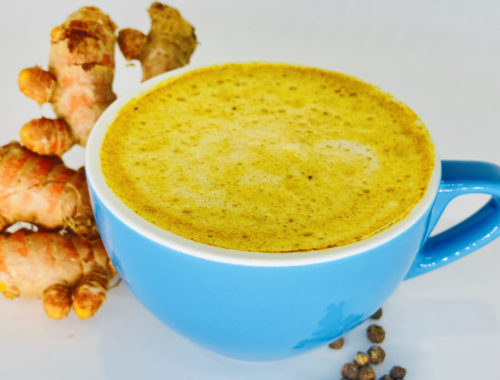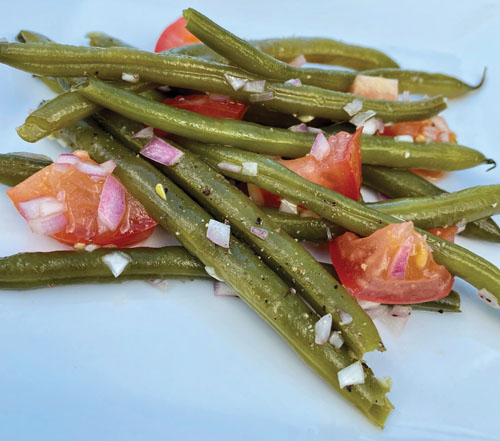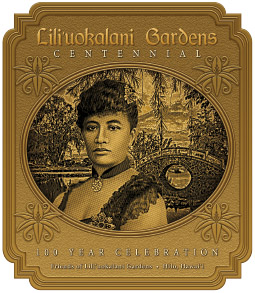
A Garden Fit for a Queen: Celebrating Lili‘uokalani In Her Garden’s Centennial Year

By Brittany P. Anderson & Leilehua Yuen

As the sun rises steadily over Hilo Bay on a bright Saturday morning, a group of college students rake leaves at the far end of Lili‘uokalani Gardens. While dozens of early morning walkers and runners do their laps around the park’s outer walkways, a couple strolls through the winding path in the middle of the garden with shovels in hand.
After two years of construction beginning in 1917, Lili‘uokalani Gardens opened in 1919 and has been serving the community as a meeting place, recreational park, and tourist attraction ever since. The park’s wide sidewalks around the perimeter and meandering pathways within offer safe, beautiful places for people to spend time. The iconic red bridge, imported a century ago from Japan, stars in many photos of Hilo and was even featured on a US postage stamp this year. One of Hawai‘i County’s most heavily used parks, and the crown jewel of Hilo’s public parks, isn’t only named in honor of Hawai‘i’s last queen — Lili‘uokalani herself played a part in its inception.
Japan–Hawai‘i Ties
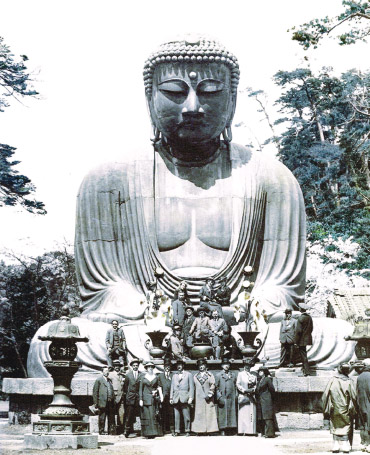
As leaders of an independent nation recognized by other nations throughout the world, Hawai‘i’s monarchs maintained relationships with other countries. Japan enjoyed an especially close relationship with Hawai‘i, especially in the later years of the monarchy.
On his visit to Japan in 1881, Kalākaua was received by Emperor Meiji, with the military band playing Hawai‘i Pono‘ī as his ship pulled into port. He was the first foreign monarch received in Japan.
Lili‘uokalani continued her brother (and royal predecessor) Kalākaua’s keen interest in Japan and learned Japanese so she could speak with the people. Lili‘uokalani’s steward, Mr. Fujimoto, was Japanese, his children were born in her home, and the Queen was their godmother.
In the “high society” of the late 1800s and early 1900s, building a Japanese tea garden “was the social thing to do,” said KT Cannon-Eger, founder of the Friends of Lili‘uokalani Gardens. Kalākaua and his wife Kapi‘olani had one built at their home on Beretania St. in Honolulu by Japanese gardeners. Robert Irwin, the Kingdom of Hawai‘i’s minister to Japan in the days of Kalākaua, had a Japanese garden at his Waikīkī home designed by the same gardeners. (His summer home in Japan was in Ikaho, where a companion festival to the Merrie Monarch Festival is held every year. The home is maintained today as a museum.)
Skylark Rosetti has been involved in the He Hali‘a Aloha No Lili‘uokalani Festival for nearly two decades. She shares that the land on which Lili‘uokalani Gardens sits had once belonged to Ke‘elikōlani, great-granddaughter of King Kamehameha, royal governor of Hawai‘i Island. Ke‘elikōlani was one of the most powerful, wealthiest people in her time.
The bulk of Ke‘elikōlani’s estate was given to her cousin Bernice Pauahi, which later became the endowment of the Kamehameha Schools. However, the land at Makaokū in Hilo, including the Waihonu fishpond, was given to Lili‘uokalani.
Vision: A Garden For Hilo
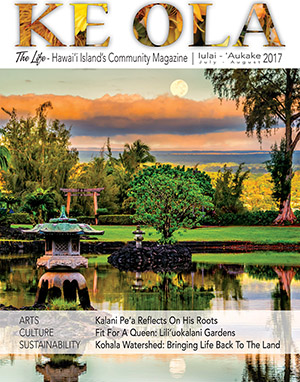
While traveling in Japan in 1914, Hawai‘i Island resident Laura Kennedy fell in love with the highly stylized Japanese gardens. Captivated by the tranquility and high fashion of the time, Laura came back to her Bide-a-Wee estate in Volcano Village yearning for a Japanese garden of her own. Mr. Yamamoto, a Japanese gardener from Kyoto, was employed to make Laura’s dream come true. By 1916 the Bide-a-Wee garden was completed—and Mr. Yamamoto’s services would soon be called on again.
Mrs. Machida was president of the Hilo Japanese Women’s Friendship Association of Hilo — Fujin Shinkokai — that had formed in 1912 to seek a location for lanterns and a potential tea house. The name of the group is carved on the two oldest stone lanterns in the garden. Fujin Shinkokai acquired the lanterns from Japan, in hopes of installing them in a Japanese garden at Mo‘oheau. That park, however, was bounded by the railroad tracks, commercial buildings, and the ballpark. With nowhere to grow, they looked toward Makaokū.
At the time, Lili‘uokalani was a frequent visitor to Hilo. She joined her friends Laura Kennedy and Mrs. Machida, and the three spearheaded the effort to install a Japanese tea garden in Hilo. Friends of Lili‘uokalani Gardens member Bill Eger said that creating the garden was “a favorite goal of Queen Lili‘uokalani.”
It must have been a great pleasure to Lili‘uokalani, then, to learn in April 1917 that the territorial government’s efforts to make her former lands into a tea garden were under way. With additional lands, the garden was to be 17 acres. As Mr. Yamamoto began his construction on Lili‘uokalani Gardens in November 1917, the beloved ali‘i passed away. She was 79.
A Park For The People

Despite the death of its namesake and a tsunami inundation in September 1918, Lili‘uokalani Garden was completed and opened to the public in 1919. Another tsunami hit Hilo’s shore in February 1923, damaging the park. The larger, deadlier tsunamis in April 1946, and May 1960 wreaked further havoc as the huge waves, as high as 36 feet, crashed into the island and churned across the gardens. Each time, the park was rebuilt.
In 1927, management of Lili‘uokalani Gardens was transferred from the State of Hawai‘i to the County of Hawai‘i. Mokuola was added to the park in 1933.
Mrs. Machida’s dream of a traditional tea house was realized in 1972. A chashitsu, both the traditional tea house and garden, were installed. They were a gift of Dr. Shōshitsu Sen, the 15th Grand Tea Master of the Urasenke Foundation in Kyoto. Tragically, arsonists destroyed the tea house in 1994. It was rebuilt in the present location in 1997, making this year the 20th anniversary of the Shoroan tea house. The new tea house garden was designed and installed by Waimea’s Fred Nonaka, a long-time friend of Mr. Nakamura, the original designer. Many of the rocks, walkways, and tsukubai (water basins) from the old tea house garden were relocated in the present one.
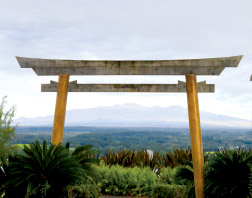
The garden’s footprint grew over the years. In recognition of the 200th anniversary of the United States of America, the three-acre Bicentennial Park was added in 1976. In 2002, then-governor Ben Cayetano added Rakuen (Happiness Park, behind the Suisan fish market) and Isles, a half-acre shoreline park popular for fishing and picnicking. These additions brought the garden’s size to just shy of 25 acres.
Perhaps the biggest changes to the garden that made it into the accessible, enjoyable park that it is today came in the year 2000 at the hands of then-mayor Stephen Yamashiro. “It was a beautiful job. It was his hana hou as mayor,” Skylark recalled.
Mayor Yamashiro pushed the $2 million project which not only refurbished the entire park, it also improved accessibility and infrastructure.
Because it is a Japanese garden, the park became a natural place to commemorate ties with Hawai‘i County’s sister cities, six of which are in Japan. One stone monument commemorates our longest-standing sister city relationship with Izu Ohshima, Japan—established in 1962. Black pine trees were planted to commemorate other anniversaries with Japanese sister cities, like Hawai‘i County’s 15th anniversary with Sumoto in 2015, or our 20th anniversary with Yurihama in 2016.
A Little Help From Friends
Lili‘uokalani Gardens is maintained by a collaboration between Hawai‘i County and the nonprofit organization Friends of Lili‘uokalani Gardens. Volunteers from the University of Hawai‘i at Hilo, local high schools, and residents join Friends of Lili‘uokalani Gardens for restoration days throughout the year.
KT Cannon-Eger founded Friends of Lili‘uokalani Gardens in 2012. It was at Bide-a-Wee—Laura Kennedy’s estate—in Volcano Village that she was first introduced to Japanese gardens when hired for landscape work by the estate’s current owner.
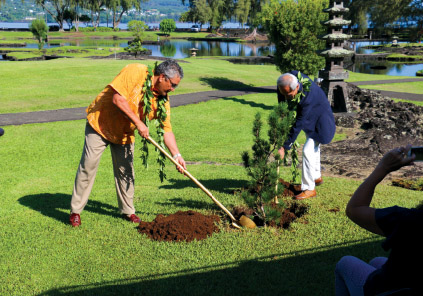
KT found herself pruning and taking care of the Bide-a-Wee estate regularly. Inspired to learn more about Japanese gardening, KT travelled to Japanese gardening conventions several times. Each convention she would speak about Lili‘uokalani Gardens, networking with some of the most renowned Japanese gardeners in the world. She learned of the connection between Laura Kennedy and Lili‘uokalani Gardens through extensive research on the history of Japanese gardens in Hawai‘i. It was clear to her that Lili‘uokalani Gardens needed to be brought back to its former glory.
“Lili‘uokalani Gardens is a living treasure,” KT muses while retelling the series of events. With her husband Bill, KT set out to visit as many Japanese gardens as possible to learn from them and bring that knowledge back to Hilo. During her exploration, she collected information on the organizations that assisted counties in caring for the gardens. KT’s investigation paid off, and the non-profit Friends of Lili‘uokalani Gardens was created.
Hawai‘i County maintains its public parks by mowing, pruning, and removing debris. This maintenance is viewed as necessary and for public safety, generally not with complicated aesthetics in mind. A complex garden system with such purposeful landscaping like Queen Lili‘uokalani Gardens requires more specialized care and precision.
KT first approached Hawai‘i County in 2009 to teach Japanese gardening techniques to maintenance crews. The board of Friends of Lili‘uokalani Gardens formulated a handshake agreement with the county to take over certain higher-skilled maintenance tasks. With the county’s support, the organization also held a seminar for all the county grounds crews, teaching the basics of Japanese gardens.
Utilizing a network of volunteer groups like Hilo’s Rotary Club, Lions Club, Waiākea High School clubs, University of Hawai‘i at Hilo students, and countless others, Lili‘uokalani Gardens began to take shape again.
The past few years have been busy with preparation for the centennial, including maintenance efforts such as thinning the bamboo thicket and removing muck from the fishponds, celebrating the US Priority Mail stamp featuring the gardens, and preparing for the upcoming regional conference of the North American Japanese Garden Association.
“We really want this to be the best garden it can be,” KT explains as she surveys the Lili‘uokalani Gardens landscape. On this particular Saturday, a large eclectic group of volunteers have turned out to assist in pruning, weeding, pond mucking, and edging. Each one signs in and gets to work with almost giddy enthusiasm. “There have been moments of revitalization to honor the ancestors, but let’s make sure this lasts in good quality for future generations,” KT says with a smile.
Standing at the edge of Waihonu, shovel in hand, a college student scoops muck and clods into large buckets. Friends board member Alton Okinaka oversees the task as a group trims sago palms behind him. “We’ve collected 1,500 gallons of muck out of the pond so far,” he says. Friends of Lili‘uokalani Gardens transports the waste to University of Hawai‘i at Hilo’s agriculture farm where it is composted for one year. “They compost it to get the salt out and then use it as soil, it is really great soil after that,” explains Alton, who is also a professor at UH Hilo.
Lili‘uokalani Gardens hasn’t been without its challenges. In the 1990s vandals burned down the original tea house. Japanese lantern statues have been knocked over or destroyed. The original red bridge—financed by Laura Kennedy’s husband and shipped in pieces from Japan—was destroyed in a tsunami. Using donated family photographs, reproduction items were made by local craftsmen to replace the damaged or lost objects. While explaining the significance of the donated photographs, an antique image of the red bridge catches KT’s eye. “Look, I think we need to add an extra piece right in here,” she says holding her hand up pointing to the embellishments missing in the replica.
The sense of community that exudes from Friends of Lili‘uokalani Gardens is palpable. “The hope is that students that come out and volunteer will feel a connection with the community and that will keep them here after graduation,” Professor Okinaka says regarding the strong college and high school presence on volunteer days. Professor Okinaka is faculty advisor to several student organizations on the UH Hilo campus. “We’re making this is a regular thing that students can be a part of,” he explains. Students go off in groups of three to edge the ponds and pull weeds from rock formations. Every single student has a smile on their face, even during the light drizzle that has blown in from the bay.
As the cleanup is going on, a couple out for a stroll becomes so inspired by the volunteers that they too sign in and get to work. “This park was and is built with aloha,” KT beams with pride.
Many of the residents attending the volunteering event learned of it by following Friends of Lili‘uokalani Gardens on social media. “I saw the event on Facebook and well, I was driving by and had an hour so here we are to help,” says resident Kim Pierce with her young son in tow. They work together pulling weeds, and playing amongst the rocks. Multiple generations toiling side by side on a typical Hilo Saturday morning give hope that KT’s vision of preserving Lili‘uokalani Gardens for future generations will come true.
Celebration
An annual festival celebrating Lili‘uokalani will take on extra special meaning this year, at the centennial of the garden built on the Queen’s land at her behest. On Saturday, September 9, 2017, the normally serene gardens will be filled with music and motion as hundreds of hula dancers express their aloha for Lili‘uokalani, hula, Japanese culture, and the blended community which defines our islands today. He Hali‘a Aloha No Lili‘uokalani Festival, celebrates “Beloved Memories of Lili‘uokalani.”
“’Free Family Fun’ are the three words that, to me, capture the essence of He Hali‘a Aloha No Lili‘uokalani,” says KT Cannon-Eger. “Celebrating the Queen’s birthday is a day-long affair in the gardens with mass mele and hula (song and dance), a rain of orchids, cultural demonstrations, craft displays, children’s activities and games, food booths, and more.”
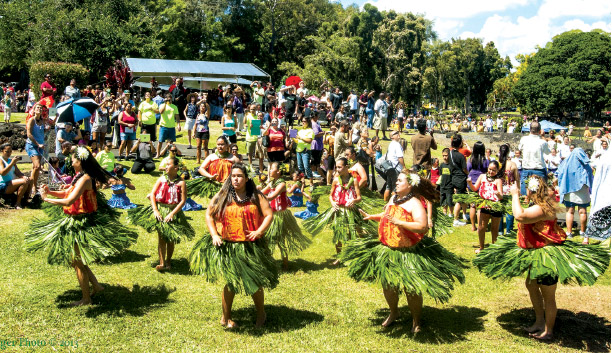
Live entertainment in the past has included Darlene Ahuna, Mark Yamanaka, the Christy Lassiter Trio, Kahulanui, Lito Arkangel, Komakakino, and the Waiākea Ukulele Band. The 2017 lineup was not available as of press time, so watch for this year’s lineup as the event gets closer.
The highlight of the event, the mass hula, fills the park with dancers from around the world, each arrayed in the regalia of their hālau and performing the designated hula in the tradition of their own kumu, a living demonstration of the ‘ōlelo no‘eau, “‘A‘ohe pau ka ‘ike i ka hālau ho‘okahi”—Not all knowledge is in one school.
In addition to the scheduled special activities, there is vending of traditional Hawaiian crafts, music throughout the day, and a “park passport” to help attendees find all the different offerings. This year, Hawaiian games, lei making, and hula lessons are expected to add to the festivities.
Skylark began her association with He Hali‘a Aloha No Lili‘uokalani 18 years ago as a member of the organizational committee, and as MC of the first celebration in 1999. She shares that then-mayor Stephen Yamashiro and Paula Helfrich of the Hawai‘i Island Economic Development Board were instrumental in establishing the celebration. Over the years the festival has grown to include the county, Lili‘uokalani Trust, Friends of Lili‘uokalani Gardens, and other local organizations.
“It’s a wonderful family event. We hope that the families will stay for the day. After the hula presentation and rain of orchids, there are all kinds of activities for the children to do,” said Roxcie Waltjen, Administrator of Culture & Education with the county Department of Parks & Recreation.
Roxcie credits Hilo Kumu Hula ‘Iwalani Kalima with developing one of the festival’s highlights, the mass hula. “She coordinated the mass hula for many years and was successful in bringing hālau from as far away as Japan to participate,” Roxcie said. Skylark added that Kumu ‘Iwalani’s efforts to organize the mass hula fulfilled a dream of her Kumu Hula George Naope, “who always wanted to see keiki dance in that park.”
KT adds, “For this year, I’d like to see the entire pond ringed with hula dancers. Everybody who has ever danced before, everybody who has never danced before, everyone come!” ❖
Find the Friends of Lili‘uokalani Gardens on Facebook.
